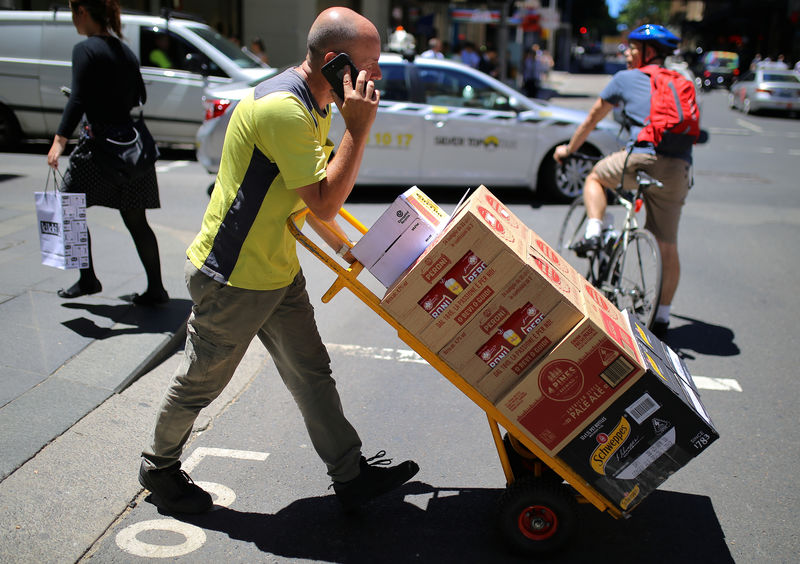(Bloomberg) -- Australia’s economy expanded at the slowest pace in almost a decade as a prolonged housing downturn weighed on consumer spending, underscoring the central bank’s decision to lower interest rates.
Gross domestic product advanced 0.4% in the first three months of the year from the prior quarter, statistics bureau data showed in Sydney. The economy grew just 1.8% from a year earlier, the weakest reading since the global financial crisis, as households boosted their savings and cut spending in a classic response to wealth erosion.
“The data confirm that the economy started 2019 very softly,” said Sarah Hunter, head of macroeconomics at BIS Oxford Economics in Sydney. “Consumers continue to be battered by weak income growth, and this was added to by the drag from sharply falling house prices.”
The currency was little changed after the GDP release.
The report comes a day after the Reserve Bank cut rates for the first time in almost three years to revive consumption that accounts for almost 60% of GDP, and spur economic growth. Governor Philip Lowe says the easing should encourage hiring and investment and help lower unemployment. The wild card is the escalating trade war between the U.S. and China.
The rise in protectionism has prompted Lowe’s (NYSE:LOW) U.S. counterparts to consider reversing some of last year’s tightening. Federal Reserve chief Jerome Powell signaled overnight an openness to cut if necessary, pledging to closely watch the fallout from disputes between the U.S. and its largest trading partners.
Lowe is expected to ease again this year -- with a better than 60% chance of an August cut -- to bring the cash rate to a new record-low 1%. Such a level, together with an easing of lending restrictions, should help put a floor under tumbling property prices that have prompting consumers to rein in spending. In Sydney, housing has fallen 15%.
Wednesday’s report showed government spending and exports were key drivers of the expansion, adding 0.2 percentage point apiece. Dwelling investment fell 2.5% and home ownership transfer costs slumped 13% amid the property downturn, collectively shaving 0.3 percentage point from economic growth.
The household savings ratio advanced to 2.8% from a revised 2.6% in the final three months of the year.
Australia’s economy is on the cusp of 28 years of expansion, a developed world record; but growth drivers are thinning with the end of the mining and property booms. Government investment in infrastructure has become an important source of growth and hiring and Lowe, in a speech Tuesday night, encouraged it to keep stoking the economy.
Unemployment Focus
The RBA needs the economy expanding at 3% or more to drive the jobless rate down to 4.5%, the level at which Lowe now believes will stoke consumer prices sufficiently to return inflation to the central bank’s 2-3% target. But outside government spending and high resource prices -- reflected in the terms of trade jumping 3.1% in the quarter -- the economy looks moribund.
“For the RBA, today’s data are slightly below its May forecast profile for growth, but recent comments indicate that it remains more focused on the unemployment rate,” said Kaixin Owyong, markets economist at National Australia Bank Ltd. “The RBA will likely be relieved not to make another major change to its growth outlook, although the governor has emphasized that its outlook is conditioned on the cash rate falling to 1%.”
Unemployment climbed to 5.2% in April and job advertisements slumped 8.4% in May, a potential harbinger to further weakness in the labor market.
What Bloomberg’s Economists Say
“Several factors may boost household spending and investment in the second half. The government has promised tax cuts and the housing market is showing signs of stabilization. Additional easing may also be in the pipeline.”
-- Tamara Mast Henderson, EconomistClick here for the full report
The RBA had incorporated a softening of the economy in the first half of the year in its most recent forecasts, predicting 1.75% growth in the 12 months through June before accelerating to 2.75% at the end of the year.
The slowdown, together with the escalating trade war, has prompted economists like Westpac Banking Corp.’s Bill Evans to forecast a further two rate cuts by November, and JPMorgan Chase & Co (NYSE:JPM).’s Sally Auld to predict another three by mid-2020, taking the cash rate down to 0.5%. Lowe suggested in a speech Tuesday night that this wasn’t his take.
Asked after the address where he saw the lower bound of the RBA’s cash rate, he said: “If you look at what happened in the U.K., the U.S. and Canada, rates got to 0.25-0.5% there, so I think for many economies that’s judged to be the effective lower bound. I’m not anticipating to get to those levels.”
